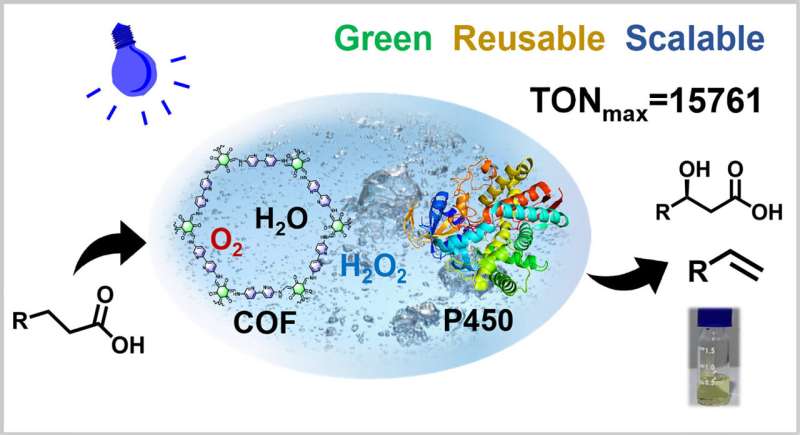
A research team designed and built a photoenzymatic cascade by combining photochemical water oxidation/O2 reduction with P450 peroxygenase catalysis to achieve efficient visible-light-driven oxidation of a range of fatty acids (C12-C20), leading to production of α-alkenes and hydroxyl fatty acids.
Fuels and oleochemicals have been chemically produced from abundant biological oils or fatty acids for more than a century, and modern biotechnology is now accelerating the advances in fatty acid chemistry.
In recent years, enzymatic synthesis has been emerging as an effective way to produce value-added chemicals from renewable fatty acids. However, it is challenging to build a holistic catalytic system that requires only light, water and dioxygen for efficient conversion of the naturally abundant fatty acids.
The photo-biocatalytic system they established no longer requires any conventional sacrificial reagent or stabilizer, and the transformation of naturally abundant fatty acids into value-added products can be conveniently achieved by using two catalysts, water, air and light. This “green” process gave a promising TON > 15,000 for both P450BSβ and P450BSβ-DC and achieved gram scale production of α-olefins.
This represents the most efficient H2O2-supplying system to support the catalytic activity of P450 peroxygenases so far. Besides, their successful establishment of the COF-TfpBpy/P450 peroxygenase hybrid system presents a new example of utilizing solar energy to drive enzymatic conversions, providing a new and promising application of COFs.
Considering the simplicity, productivity and reusability of the photocatalyst COF-TfpBpy and scalability of the established cascade, they envision a more catalytically efficient, environmentally friendly, sustainable, and cost-effective cascade reaction will be available upon more optimization and development for large scale bioproduction of 1-alkenes and hydroxyl fatty acids from abundant fatty acid substrates.
The study is published in the journal Science Bulletin.
This study was led by Prof. Dr. Shengying Li (State Key Laboratory of Microbial Technology, Shandong University) and Ass. Prof. Dr. Biaobiao Zhang (School of Science, Westlake University).
More information:
Yuanyuan Jiang et al, Photoenzymatic synthesis of 1-alkenes and hydroxyl fatty acids by cascading a COF photocatalyst and P450 peroxygenases, Science Bulletin (2024). DOI: 10.1016/j.scib.2024.04.069
Citation:
Photoenzymatic synthesis achieves efficient oxidation of fatty acids (2024, July 8)
retrieved 8 July 2024
from https://phys.org/news/2024-07-photoenzymatic-synthesis-efficient-oxidation-fatty.html
This document is subject to copyright. Apart from any fair dealing for the purpose of private study or research, no
part may be reproduced without the written permission. The content is provided for information purposes only.







